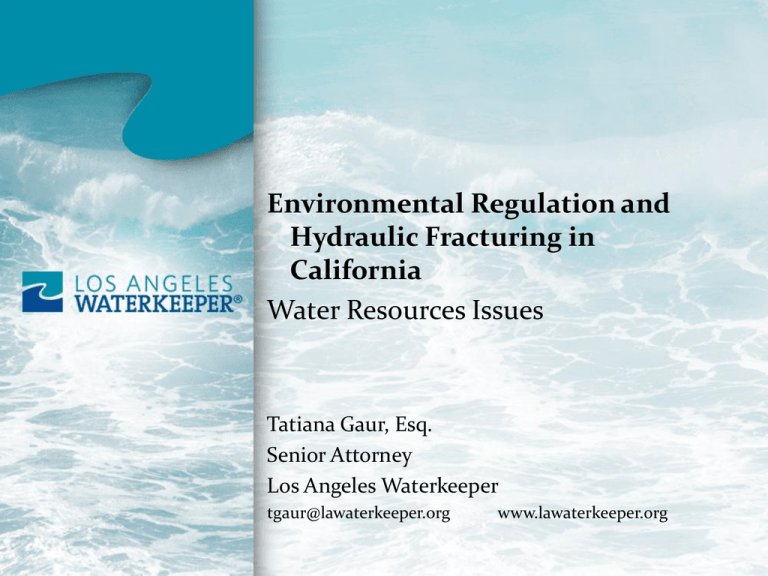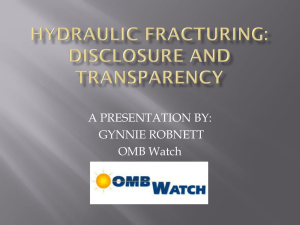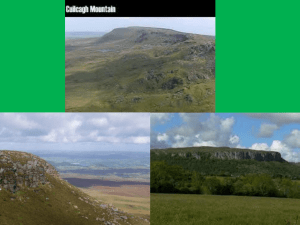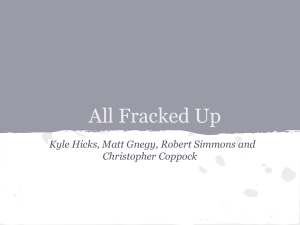Environmental Regulation and Hydraulic Fracturing in California
advertisement

Environmental Regulation and Hydraulic Fracturing in California Water Resources Issues Tatiana Gaur, Esq. Senior Attorney Los Angeles Waterkeeper tgaur@lawaterkeeper.org www.lawaterkeeper.org Fracking – Some basics Fracking, or hydraulic fracturing – method of oil stimulation to cause or enhance the production of oil and gas: Blasting millions of gallons of water, mixed with sand and chemicals, including toxic chemicals, under high pressure deep into the earth to break up rock formations and allow oil and gas extraction. Fracking has been reported in at least 10 counties in California, including Los Angeles. Most California fracking is for oil, not gas. Fracking involves the use and production of fluids – Hydraulic fracturing fluid – fluids mixed with additives used for fracking Flowback fluid – the hydraulic fracturing fluid when it returns to the surface after the pressure is released Produced water – all wastewater that emerges from the well after production begins Each of these fluids can contain harmful chemicals such as heavy metals (lead, iron, copper; BTEX compounds; radioactive compounds depending on the shale formation; TSS, oil and grease; VOCs and others) Fracking is a concern because of serious impacts on groundwater and surface water resources. At least 1000 instances of water contamination caused by fracking and drilling throughout the United States. Other well stimulation techniques – acidizing, gravel packing. MONTEREY SHALE FORMATIONS • US Energy Information Administration reduced by 96% its estimate of recoverable oil from Monterey Shale Oil Formations – from nearly 14 billion barrels to 600 million barrels. Impacts on Water Resources Water Supply - fracking is water intensive! Water Quality Groundwater impacts Well integrity failure; spills and leaks of fluids; contamination from underground water injection wells used to dispose waste water Surface water impacts Improper treatment and/or disposal of fracking fluids; spills and leaks to surface waters Los Angeles County Oil Fields Well Stimulation and Groundwater in Los Angeles County LA County Water Resources Impaired Surface Waters – Ballona Creek, LA River and tributaries, San Gabriel River, Santa Clara River, coastal waters, including San Pedro Bay, LA/LB Harbor and Santa Monica Bay Groundwater – four groundwater basins: Santa Monica, Hollywood, West Coast and Central Basin; all, except a small portion in West Coast Basin underlying El Segundo seaward of the basin’s seawater intrusion and the Ports of LA and Long Beach, are designated as existing municipal and domestic water supply. Regulation of fracking – Federal Requirements Clean Water Act - regulates discharges of pollutants from point sources into waters of the US Discharges of fracking wastewater from oil and gas production point sources into surface waters are prohibited – 40 C.F.R. § 435.32. Discharges of fracking waste water to waste treatment plants (“indirect discharges”) are subject to pretreatment requirements - 40 C.F.R. § 403.3(i). Discharges of storm water associated with oil and gas drilling and production activities are exempt from CWA regulation The Energy Policy Act of 2005 expanded the exemption to include storm water discharges from oil and gas construction activities (i.e. fracking) BUT the EPA rule implementing the exemption was declared unlawful and vacated. Regulation of fracking – Federal Requirements Safe Drinking Water Act Injection of wastewater regulated by EPA’s Underground Injection Control program (UIC) to protect underground sources of drinking water. EPA did not classify oil and gas wastewater as hazardous and injection wells associated with this type of wastewater are designated as Class II (more relaxed controls than Class I wells) Further, injection of wastewater for disposal is regulated by SDWA while injection of fluids and propping agents for the purpose of oil and gas production (i.e. fracking) is not regulated by the UIC as Class II well, except when diesel fuels are used in fracking fluids (exemption in 2005 Energy Policy Act) Regulation of Fracking – State Requirements Department of Conservation, Division of Oil, Gas and Geothermal Resources (DOGGR) has primary responsibility for regulating oil and gas activities in California. Until 2012, there was minimal regulation and oversight of fracking and well stimulation activities no notice, no monitoring or reporting, no permit. DOGGR did not even know where and how often fracking occurred in California. MOA with State Water Board regarding regulation of Class II injection wells. In December 2012, DOGGR released a discussion draft regulations of hydraulic fracturing. Regulation of Fracking – State Requirements In 2013, SB4 was adopted to improve regulation of fracking and acidizing well treatments SB 4 Requirements Independent scientific study on well stimulation treatments to evaluate hazards and risks on natural resources and public health and safety - by January 1, 2015 DOGGR must develop well stimulation treatment regulations by January 1, 2015 Permits required for well stimulation Notice to public and regulatory agencies – well location; water management plan anticipated amount and source of water for treatment, disposal method for the wastewater; chemicals in fracking fluid; time period of well treatment; groundwater monitoring plan; estimated amount of treatment-generated waste and disposal method. Exemption from public disclosure for chemical constituents claimed to be trade secret New agreements with Water Boards, DTSC, Air Boards delineating authority, notification and reporting requirements – January 1, 2015 State Water Board must develop groundwater monitoring model criteria by July 2015 DOGGR Regulations • Exempt from regulation certain acid treatments • Narrow definition of protected water (10,000 mg/L TDS) – should be expanded to include all federal and state waters with beneficial uses, regardless of TDS levels • Stronger public notice requirements and opportunity for public comment • Permit application should also include baseline groundwater monitoring data and spill contingency plan to address impacts on water bodies • Water testing during and after the fracking should be required • Disclosure of chemicals to be used for fracking 60 days prior to instead of after well treatment. Tatiana Gaur, Esq. Senior Attorney Los Angeles Waterkeeper tgaur@lawaterkeeper.org www.lawaterkeeper.org 310-394-6162 x102







![Health & HVHF [High Volume Hydraulic Fracking]](http://s2.studylib.net/store/data/005495293_1-13339bf0c44b2072f4983970072093cd-300x300.png)

